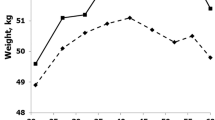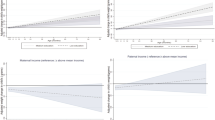Abstract
Background/Objectives:
We test the impact of several demographic, economic and social factors on stature in an early nineteenth century environment.
Subjects/Methods:
We use a database of conscripts from the period 1818–1860 of a rural province in The Netherlands (Drenthe). This area had a rather high biological standard of living. This database of 413 conscripts contains information about family structure, family rank order, height, tax income, occupation and age of death. Conscripts came from two communities: one from a particular village (Oosterhesselen) and the other was Jewish conscripts that came from the countryside of the province.
Results:
Our statistical analysis shows a positive significant relationship between family size and height, which confirms the resource dilution theory. Remarkably, the sign of the relation between family size and life expectancy is inverse. Other factors such as the potato crisis and income had the expected effect on conscript heights. The community effect was strong. Jewish conscripts were much shorter than their counterparts. Access to nutrition, the specific food laws and other factors can explain this difference.
Conclusions:
An increasing sibship size had a negative impact on body height but positive effects on life expectancy when adulthood was reached. Specifically for the Jewish community was the positive effect of the death of the father on conscript height. The mechanisms behind this phenomenon are unclear and open for further research.
This is a preview of subscription content, access via your institution
Access options
Subscribe to this journal
Receive 12 print issues and online access
$259.00 per year
only $21.58 per issue
Buy this article
- Purchase on Springer Link
- Instant access to full article PDF
Prices may be subject to local taxes which are calculated during checkout
Similar content being viewed by others
References
Tassenaar V . De biologische levensstandaard in Drenthe, 1815-1860. Het verloren Arcadia. Labyrinth Publisher: Capelle ad Ijssel, The Netherlands, 2000.
Öberg S . Sibship size and height before during and after the fertility decline: A test of the resource dilution hypothesis. Demogr Res 2015; 32: 29–74.
Ripley WZ . The Races of Europe: A Sociological Study. D. Appleton and Co: New York, 1899.
Bolk L . Over de toeneming in lichaamslengte der mannelijke bevolking in Nederland. Ned Tijdschr Geneeskd 1909; 53: 1703–1721.
Kopczynski M . The physical stature of Jewish men in Poland in the second half of the 19th century. Economics and Human Biology 2011; 9: 203–210.
Bogar D . Wealthier Jews, taller Gentiles: inequality of income and physical stature in fin-de-siècle Hungary. Econ Human Biol 2013; 11: 433–435.
Hermanussen M, Meitlinger T, Veldhuis JD, Low MJ, Pfäffle R, Staub K et al. Adolescent growth: genes, hormones and the peer group. Pediatr Endocrinol Rev 2014; 11: 341–353.
Bogin B, Hermanussen M, Blum WF, Aßmann C . Sex, sport, IGF-1 and the community effect in height hypothesis. Int J Environ Res Public Health 2015; 12: 4816–4832.
Becker GS . A Treatise on the Family. Harvard University Press: Cambridge, 1993.
Oppers VM . Analyse van de Acceleratie van de menselijke Lengtegroei door Bepaling van het Tijdstip van de Groeifasen. University of Amsterdam: Amsterdam, 1963.
Alter George, Oris Michel . Effects of inheritance and environment on the heights of brothers in nineteenth-century Belgium. Human Nature 2008; 19: 44–55.
Hermanussen M, Hermanussen B, Burmeister J . The association between birth order and adult stature. Ann Human Biol 1988; 15: 161–165.
Karel EH, Paping R . In the shadow of the nobility: local farmer elites in the Northern Netherlands from the 17th to the 19th century Freist D, Schmekel F . Hinter dem Horizont: Projection und Distinktion ländlicher Oberschichten im europäischen Vergleich 17. bis 19. Jahrhundert. Aschendorff Verlag: Münster, 2013; 43–54.
Author information
Authors and Affiliations
Corresponding author
Ethics declarations
Competing interests
The authors declare no conflict of interest.
Rights and permissions
About this article
Cite this article
Tassenaar, V., Karel, E. The power of the kashrut: older but shorter. The impact of religious nutritional and hygienic rules on stature and life expectancy of Jewish conscripts in the early 19th century. Eur J Clin Nutr 70, 667–670 (2016). https://doi.org/10.1038/ejcn.2016.24
Received:
Accepted:
Published:
Issue Date:
DOI: https://doi.org/10.1038/ejcn.2016.24



